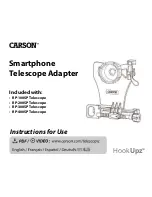
LG-RD2030
93
LG-RD2030
92
FDA and the Cellular Telecommunications & Internet
Association (CTIA) have a formal Cooperative
Research and Development Agreement (CRADA) to
do research on wireless phone safety. FDA provides
the scientific oversight, obtaining input from experts
in government, industry, and academic organiza-
tions. CTIA-funded research is conducted through
contracts to independent investigators. The initial
research will include both laboratory studies and
studies of wireless phone users. The CRADA will
also include a broad assessment of additional
research needs in the context of the latest research
developments around the world.
7. How can I find out how much radiofrequency
energy exposure I can get by using my wireless
phone?
All phones sold in the United States must comply
with Federal Communications Commission (FCC)
guidelines that limit radiofrequency energy (RF)
exposures. FCC established these guidelines in con-
sultation with FDA and the other federal health and
safety agencies. The FCC limit for RF exposure from
wireless telephones is set at a Specific Absorption
Rate (SAR) of 1.6 watts per kilogram (1.6 W/kg). The
FCC limit is consistent with the safety standards
developed by the Institute of Electrical and Electronic
Engineering (IEEE) and the National Council on
Radiation Protection and Measurement. The expo-
sure limit takes into consideration the body_ ability to
phones would provide some of the data that are
needed. Lifetime animal exposure studies could be
completed in a few years. However, very large num-
bers of anime health effects, such as cancer. This is
because the interval between the time of exposure to
a cancer-causing agent and the time tumors develop
- if they do - may be many, many years. The inter-
pretation of epidemiological studies is hampered by
difficulties in measuring actual RF exposure during
day-to-day use of wireless phones. Many factors
affect this measurement, such as the angle at which
the phone is held, or which model of phone is used.
6. What is FDA doing to find out more about the
possible health effects of wireless phone RF?
FDA is working with the U.S. National Toxicology
Program and with groups of investigators around the
world to ensure that high priority animal studies are
conducted to address important questions about the
effects of exposure to radiofrequency energy (RF).
FDA has been a leading participant in the World
Health Organization International Electromagnetic
Fields (EMF) Project since its inception in 1996. An
influential result of this work has been the develop-
ment of a detailed agenda of research needs that
has driven the establishment of new research pro-
grams around the world. The Project has also helped
develop a series of public information documents on
EMF issues.
















































